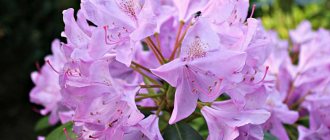Tree peonies amaze gardeners with their beauty and delightful aroma. To effectively plant them in a flowerbed, the owner should choose the right variety, study the intricacies of planting peonies from seeds, the peculiarities of dividing bushes, the rules of propagation by cuttings, layering and grafting.
Tree peony is a deciduous shrub that grows to a height of up to two meters. It has straight massive stems of light brown color, which, unlike most other flowers, do not die off in the fall, but grow and thicken every year, forming a hemispherical bush. The tree peony has beautiful openwork leaves and large (12 - 20 cm in diameter) flowers. Depending on the variety, the buds may have different shapes and colors. All this, coupled with excellent cold resistance, makes the tree peony an excellent garden plant for Russia, and therefore domestic gardeners should know how to plant a tree peony correctly.
Varieties of tree peonies
All modern varieties of tree peonies are based on several natural species:
- peony Lemoine,
- yellow peony,
- Delaway peony,
- Potanin's peony.
At the same time, these flowers are most actively cultivated in China. Accordingly, all varieties are divided into three main groups:
- Chinese-European peonies. These varieties are characterized by massive, heavy flowers that droop towards the ground under their own weight.
- Japanese varieties. They have relatively small, light buds that seem to float above the bush.
- Hybrids of Delaway peony and yellow peony. The most popular group of varieties, distinguished by yellow flowers.
The variety of shades of petals allows gardeners to decide at their own discretion which flowers to plant next to peonies. Among domestic flower growers today, the most common tree peonies are the following varieties:
- Kiao sisters. They are loved for their massive (up to 16 cm) two-color inflorescences - half of the bud is dark red, half is white and cream.
- Sapphire. The flowers are up to 18 cm in diameter and have a pale pink color with a dark crimson center.
- Coral altar. Another bicolor variety. The crown-shaped flowers combine salmon and white shades. The diameter of the inflorescences is up to 20 cm.
- Green Jade. Graceful light green buds.
Why leaves curl and turn black and buds dry out: peony diseases and their treatment
The plant is not considered prone to various diseases. Well, like any flowers, there are still ailments that overcome them.
Tree peonies suffer from:
- Ring spot . These are usually spots that appear on the tips of the leaves. The color of these spots is light yellow. The causative agent is a virus. Sometimes a mixed infection is recorded.
- Gray rot. This is a fungal disease that affects flowers, roots and leaves. In this case, brown spots appear on the leaves, as well as drying and rotting of the plant. The cause of the disease is an excess of nitrogen in the soil, as well as high humidity. In addition, such a disease often appears due to an incorrectly chosen place for planting. Peonies do not tolerate shade.
- Rust. It is found most often in the northern regions. Yellow or brown spots are observed on the leaves with a brown border. Triggered by fungal spores. Infection can occur due to gusts of wind.
- Brown spot . Observed in the first half of summer. Dark brown spots appear on the leaves, which then turn into holes.
- Powdery mildew . Occurs infrequently and in small outbreaks. Usually manifested by the appearance of a white border or coating on the upper part of the leaves.
- Root rot . Caused by mushrooms. Roots infected with this disease rot and die. Most often caused by high humidity and abundant watering of the plant.
Ways to fight:
- You can fight gray rot with copper oxychloride and Bordeaux mixture
- Rust is treated with phytosporin, colloidal sulfur
- Root rot is destroyed using foundationazole
- Various types of spotting are destroyed using Bordeaux mixture, copper oxychloride, and pure flowers.
- Powdery mildew can be removed using foundationazole, topaz and pure flowers
To protect against fungal diseases, after the leaves have fallen from the bush, treatments are carried out with copper sulfate or Bordeaux mixture. Such treatments can eliminate various ailments. This is a kind of prevention.
Diseases of peonies
Despite the fact that peony is a fairly common flower. Taking care of him is not at all easy. This requires time and attention from the gardener. It is necessary to carry out regular fertilizing before and during the flowering period. Also a necessary condition for obtaining a good harvest and large buds is timely pinching and pruning of bushes.
Planting tree peonies
Most amateur gardeners plant tree peonies as seedlings. This procedure is carried out only in early autumn: the second half of August - the end of September. We will tell you how to properly plant a tree peony in the spring a little later.
Choosing the right planting site is one of the most important steps in this process. Tree peonies are very capricious when it comes to sunlight. They absolutely do not like shade, so be sure to make sure that no tree or building blocks the sun in the place where the peonies will be planted. It is better from the very beginning to give preference to areas located at a certain elevation, where there is always enough sunlight.
Tree peonies prefer loamy soils, which is why it is recommended to dilute sandy soils with clay, humus, peat and turf soil. On the contrary, excessively clayey soil should be refined with sand and organic fertilizers. You should not neglect the issues of preparing a site for planting peonies, since the life expectancy of plants largely depends on the quality of the soil.
If the groundwater level is low, the hole for planting seedlings should be made in the form of a cone. Its dimensions should be 70 cm in diameter at the surface and 70 cm in total depth. Gravel, broken brick, or sand should be laid at the bottom of the cone in a layer of about 20-30 cm. If planting is carried out in acidic soil, 200-300 g of lime or bone meal should be added to the hole, and only then can you begin to fill the soil. When planting, it is recommended to water the roots of the plant abundantly so that they straighten. The hole can be completely filled with soil only after the water has been completely absorbed into the soil. It is very important that the root collar ends up exactly at surface level. Tree peonies do not tolerate very well when they are planted too deep or, conversely, too high. If you have several seedlings, place them at a distance of at least one and a half meters from each other.
How to prolong flowering
To prolong the flowering of annuals, you must constantly pluck faded flowers or inflorescences, preventing the formation of seeds. Annuals used for borders (ageratum, lobelia, lobularia and others) can be cut off when flowering, leaving 2 - 3 cm of the lower part of the stem, and then watered and fertilized. By the end of summer they will bloom a second time.
Clematis will bloom longer if some of the shoots that grow in spring are cut 30 cm from the ground. Regrown side shoots will bloom later than unpruned ones.
Peonies will bloom later if, at the end of winter, you rake snow up to the bushes, compact it and sprinkle a 5 cm layer of sawdust on top. In mid-May, the sawdust should be removed.
Roses will bloom longer and look more elegant if you regularly prune faded flowers and inflorescences.
If you cut off the stems of a perennial lupine with faded inflorescences at the base without damaging the leaves of the rosette, it will bloom a second time by autumn.
Growing tree peony from seeds
Now let's look at how to properly plant tree peony seeds. Typically, professional flower growers are involved in breeding tree peonies from seeds, since this method is much more complicated. In addition, the plant will need 5-6 years for the seed to turn into a flowering bush, while seedlings, depending on their age, can bloom in the first or second year.
In addition, for tree peony seeds to germinate, they require mandatory stratification. In addition, with more or less long-term storage, the seeds completely lose their viability. Thus, growing tree peonies by sowing requires much more patience with no guaranteed results.
The fruits of this plant ripen in September - early October. You can tell that the seeds are ready for collection by looking at the slightly open seed pod. The most viable seeds are large (up to a centimeter in length) seeds that have a shiny, smooth, dark-colored surface. Sowing is carried out after three days of drying. Seeds are placed to a depth of 3 cm in loose, fertile soil until the first frost. It is better if the soil is moist. On the eve of winter, it is recommended to cover the sowing site.
Theoretically, some of the seeds can sprout in the spring, but in most cases, tree peony germinates only in the second or even third year. It is in order to guarantee high germination already in the first spring that it is recommended to subject the seeds to temperature stratification. For this purpose, in the fall, the seeds are buried not in open ground, but in a pot or box with soil. After the pot/box of seeds has overwintered outside, it should be taken indoors in March and kept at room temperature. By following these steps, you can guarantee a fairly high germination rate even in the first spring.
An alternative way to increase the germination of seeds is to collect them immature and place them in damp sand or peat for 10-12 weeks at room temperature. After this, the seeds should be placed in the refrigerator or basement so that they remain at a temperature of 5-8 degrees for about 3 months. In May, such seeds can be planted in open ground at a depth of up to 5 cm. The seedlings should hatch before autumn and will grow very slowly. They should be watered very sparingly, and 3-4 weeks after planting they can be fed with liquid fertilizers. The soil around the shoots is mulched, and for the winter the plants need to be thoroughly covered with peat or dry leaves. You can learn more about how to properly plant a tree peony in the spring from a special video.
Why don't they bloom
The perennial does not form buds, and if they do appear, they dry out and do not open. Novice summer residents complain about such problems.
Age
The plant does not bloom immediately after planting. It takes time to please with its decorative appearance:
- In the first year, the peony adapts to new conditions and stems form.
- Over the next 12 months, the number of shoots increases, the tuber becomes thicker and stronger. Sometimes 1–2 buds appear; it is recommended to pick them off.
- In the third year, the plant forms powerful roots and single flowers.
In a few more seasons, the shade of the petals will change; the peony will not be covered with buds. After a while, the plant will respond to care with a delicate aroma and lush flowering.
Propagation of tree peonies
Like most other garden flowers, tree peonies can be propagated either by seeds or seedlings. We have already talked about how this is done. Now let's look at the main ways to get planting material.
Seeds and ready-made seedlings can be bought on the market or in a specialized nursery. This method is so simple that there is no point in describing it in detail. It is much more interesting to consider ways to independently obtain new plants. If you have at least minimal experience in floriculture and gardening, you can propagate peonies:
- dividing the bush,
- cuttings
- layering,
- vaccination.
Top dressing
In order to improve the aesthetic and functional characteristics of the tree peony, it should be fertilized with mineral elements from time to time. You can start feeding these ornamental bushes as early as April, and finish 2 weeks after the end of flowering. The optimal frequency of feeding is a period of 10-12 days. Particularly popular are mineral fertilizers with a predominance of phosphorus and potassium components. Do not forget that it is better to underfeed any plant than to “burn” it with useful mineral elements. Tree peonies in the presence of excess fertilizer are more often susceptible to various diseases.
In addition to regularly adding useful microelements to the soil, the soil within a radius of 60-70 centimeters from the bush needs to be loosened and weeded to remove weeds.
Reproduction of peonies by dividing the bush
This procedure involves transplanting part of a bush to a new location. Even a whole bush does not tolerate moving to a new place very well, and even more so a halved plant. You should resort to this technique only as a last resort, for example, if you still plan to dig up an old bush and do not value it very much.
To divide the bush, simply stretch its parts to the sides near the root collar. In this case, “surgical” intervention may be required. Make sure that the newly formed bush has sufficient buds and roots. Before planting in a new location, immerse the plant in a clay mash for 20-30 minutes.
For propagation by division, it is best to take bushes that are 5-6 years old. Separation is recommended to be carried out in August.
By the way, a few words about what flowers can be planted next to peonies: after transplantation, peonies feel very bad. It may take them several years to fully recover. In view of this, you should not plant other massive flowers nearby, which will suck water and nutrients from the common flower bed, and also create shadow.
Seedling storage
If the peony was purchased in late winter or early spring with an exposed root system, it must be temporarily planted in a container. In most cases, a 5 liter container with drainage holes is suitable. Until the peony is transplanted to a permanent location, it is necessary to maintain a temperature regime close to 0 degrees. In case of a warm winter, the seedling can be buried in the snow. Don’t forget to water the plant from time to time if the soil dries out. All these actions are necessary so that the plant can grow suction roots, which are necessary for the full and rapid development of the shrub. In addition, these actions can prevent the early growth of peony. If shoots do start to grow, the seedling should be moved to a cool, but bright room.
Reproduction by cuttings and layering
For cuttings, choose semi-woody shoots. It is better to cut them out from the second half of June. The finished cuttings should be stuck into the sand-peat mixture to a depth of 1.5 cm and covered with glass or film to create a greenhouse effect. Cuttings need to be watered and sprayed regularly. In the second half of September, rooted shoots are planted in individual pots and stored until spring in greenhouse conditions. Next year, young shoots can be planted in open ground.
The layering method is longer and takes two years. In May, before the bushes begin to bloom, you should select the most developed shoots and carefully bend them to the ground. In this case, on the side facing the soil, a small incision is made on the shoots, which should be treated with growth substance. The resulting cutting must be buried with a 10-centimeter layer of soil, and subsequently the soil above the cutting should be regularly moistened. By September, roots should appear on the branch; such a shoot can already be separated from the bush and planted in open ground in a permanent place.
Trimming
You should not be afraid of pruning, because tree peonies quickly grow new shoots. Rejuvenating pruning should be done in early spring while the plant is still dormant. Normal shoots are pruned to the growth bud, and weak branches are left no more than 20 centimeters from ground level. After a cold winter, it is necessary to check the bush for frozen branches, which should also be removed.
In order to get the largest possible inflorescences, in the spring you can safely remove 1/3 of the formed buds. When pruning tree peonies, it is important to remember that flowering occurs on last year's shoots.
Ornamental shrubs more than 8-10 years old require rejuvenating pruning, which is characterized by the removal of branches “under the stump”. This method should be used in cases where the number of inflorescences is significantly reduced and their forms become less and less lush.
Pruning ornamental shrubs
Reproduction of tree peonies by grafting
Grafting is the most reliable and popular method of industrial propagation of tree peonies. For the same reason, it is recommended to use it in a private garden.
The grafting should be done on the roots of the herbaceous peony: in early August, cuttings with two buds are cut from tree peony bushes; The lower part of the cutting is ground to form a wedge and tightly inserted into a wedge-shaped groove previously made in the roots of the herbaceous peony. The junction is tightly wrapped in film and, in this form, the grafted peonies are placed in a box filled with wet sawdust.
The box is stored in a dark place for a month, and then the rooted cuttings are planted in a container or bed in a greenhouse filled with fertile soil. The grafted peony grows and strengthens in greenhouse conditions for the next one and a half to two years. Only then can it be planted in open ground
Description of the bush
The plant belongs to the genus of deciduous shrubs and belongs to the Peony family. Peony (botan.) - botanical description:
- The bush has several trunks and its height is about one meter.
- The plant has a large root system with large roots. They look like cones.
- Dark green and reddish-bluish leaves are located one behind the other. They have a trifoliate or pinnate shape with thin or wide lobes. In autumn, the foliage turns yellow, reddish or purple.
- The buds consist of small scales that fit tightly together in a tiled pattern.
- The tree peony has single flowers with a diameter of 15 to 25 cm. The flower consists of a calyx, corolla, many stamens and from 1 to 8 pistils. The calyx consists of 5 sepals, red or dark green. The pistils are located on a fleshy disc.
- The fruit is star-shaped and has a complex multi-leaf structure. Each leaflet contains several seeds. The large, shiny, black-brown seeds have an oval or round shape. They are located along the edges of the abdominal suture.











